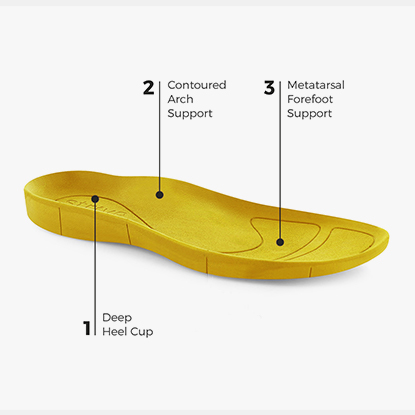There’s no doubt that Strive sandals look and feel great, but what is the science behind their superior comfort? Well, the secret is the inbuilt Biomechanical Footbed Technology™ (BFT) which has been carefully engineered by Podiatrists. Our lab has nearly 40 years of experience manufacturing foot orthotics to treat foot problems, so there’s not a lot we don’t know about great foot health!

HEEL CUP
One of the key points of BFT is our ergonomically designed heel cup, and this all starts with the shape and biological make up of your heel.
- Shape - Firstly, the bottom of your heel is rounded in shape and this means a good deep heel cup is needed to support and cradle your heel bone. It makes no sense to have a sandal with a flat, shapeless heel area because this does not reflect the natural shape of your foot.
- Structure - Secondly, between your skin and your heel bone (calcaneus), there are several layers of structures including a fat pad which acts as one of your body’s natural shock absorbers. If we walk a lot on hard flat surfaces without a supportive heel cup, this can cause the fat pad to flatten and spread slightly which makes it less effective to cushion and absorb shock. Over time, this can make you more prone to problems like heel pain.
- Science - Lastly, there’s the “Biomechanics” of it all…When you walk, your heel hits the ground first and this takes the full impact of your body weight. It’s really important that this part of the foot is well supported to create a firm foundation for your first step. A good heel cradle means that as you start to walk, your feet, knees and back are likely to fall into a more stable position. It’s a bit like making sure that the table you’re sitting at is stable before you put your coffee cup or wine glass down!
ARCH SUPPORT
It's no secret that the key to Strive's unrivalled comfort is the carefully designed contours of our footbeds (Biomechanical Footbed Technology™). The heel cup, arch profile and forefoot support are all specifically engineered to offer your feet optimal comfort and support.
We've mentioned previously that it's pretty pointless having a 2-dimensional flat footbed when the soles of our feet are 3 dimensional and contoured, especially when it comes to your arch profile.
- Shape - The shape of our arches vary from person to person. Some of us have high arches, some of us have low arches. It's not the flatness of your arches which can cause problems, it's the rate at which your foot rolls in.
- Structure - The arch of the foot is a complex structure made up of an intricate mix of bones, muscles, and ligaments. These all work together to allow the arch to contract and relax as we walk. As our foot strikes the ground, the arch lowers and these bones, muscles and ligaments become looser and more adaptive to cope with different terrains. This also acts as a natural shock absorber. As we push off to take our next step, the arch lifts and becomes stiffer so that the foot can support our body weight and propel us forward. All of this takes place with every step, but the timing has to be right.... if not, it's a bit like a car with unbalanced tyres.... eventually wear and tear occurs as a result.
- Science - Current studies suggest that a shoe or sandal with an arch support in the correct place can help to control the rate at which the foot rolls in. The latest research is also finding that "comfort" is key! This is probably because supporting the foot in its optimum position allows it to function naturally and in sync with the rest of your body. Remember: comfortable feet are essential for great wellbeing!
FOREFOOT SUPPORT
Your foot is made up of 26 bones, 33 joints and over 100 muscles, ligaments and tendons and a lot of these are in your forefoot. We’ve talked in previous blogs about the complicated makeup of the rearfoot and the arch and why the Biomechanical Footbed Technology™ in Strive footwear is so important. This month we’re going to take a closer look at why forefoot support is also crucial.
- Shape: Like your arch and your heel, the ball of your foot is not flat. The bones which make up your forefoot, called the metatarsals, form a gradual shallow “transverse arch”. This arch can effectively bottom out if unsupported which can lead to common problems and pain in this area (especially when walking on hard surfaces).
- Structure The muscles which help to support your arch and your metatarsals are called the plantar intrinsic muscles. Research has shown that these muscles play a very important role in maintaining the shape of the foot and providing balance. Latest research is also suggesting that footwear does not weaken these muscles (as previously thought).
- Science: Incorporating a “metatarsal support” into the footbeds of Strive footwear helps to support your natural forefoot arch and spread any high-pressure areas over a wider area. This means that the integral structure of your forefoot is held in its optimum position which helps to prevent the stresses and strains which can lead to pain.